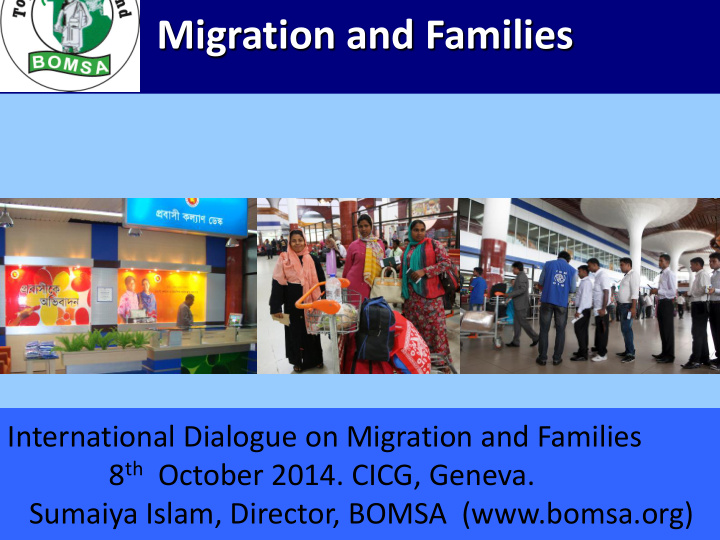



Migration and Families International Dialogue on Migration and Families 8 th October 2014. CICG, Geneva. Sumaiya Islam, Director, BOMSA (www.bomsa.org)
Background Background • Migration is a major option for many Bangladeshis • 8.3 million Bangladeshis live abroad as migrants • Country estimated to touch 15b USD as remittance by end of 2014
Key actors in migration management • Ministry of Expatriates’ Welfare and Overseas Employment (MoEWOE) • Bureau of Manpower, Employment and Training (BMET) • Technical training centres • Vigilance Task Force (VTF) • Labour Attachés at the Bangladesh Missions • Probashi Kallyan Bank • Government owned recruiting agency and Private recruiters • NGOs/CSOs • Wage Earners’ Welfare Board
Migration and Families • S Influenced variety of socio- economic factors To seek better job opportunities To provide adequate nutrition, housing, healthcare and education for families
Flashes in Frame : Reintegration support for Women and family of migrants
Overseas Employment from 2001-2013 875055 1000000 832609 900000 800000 607798 568062 700000 475278 600000 403793 390702 381516 500000 264190 252702 400000 225256 188965 172958 300000 200000 100000 0 2001200220032004200520062007200820092010201120122013 Source: Bangladesh Bureau of Manpower Employment and Training
Year-wise Remittances Earned from 1976 to 2013 in Million USD Source: Bangladesh Bureau of Manpower Employment and Training
Year wise overseas employment of Female Workers from 1991 to 2013 Source: Bangladesh Bureau of Manpower Employment and Training
Overseas Employment of Female Workers Source: Bangladesh Bureau of Manpower Employment and Training
Major progress in migration management • The Overseas Employment and Migrant Act 2013 • Anti Trafficking legislations: Prevention and Suppression of Human Trafficking Act 2012 • Overseas Employment Policy 2013 draft
Women Migration Government’s response to women migration: (highlights from 18 points) • Attestation of work permit, visa from BD missions • Attestation of recruiting agencies’ documents by BMET (at origin) and by BD mission (at destination) • Compulsory training • Reduced migration cost • Compulsory pre-departure orientation
Migration and Remittance • Remittance Management: ⁻ Inflow of remittances at household level impacts well-being ⁻ Women use more formal/official channels for sending remittances ⁻ Women has comparatively less control over the remitted money and it’s utilization plan
Women Migration and Families • Women’s empowerment – Social cost of migration – Women enjoy more freedom (even after confinement within 4 walls in most cases) – Self confident increased – Control over income/earning, decision – Left out/abandoned by spouse, family members – Physical torture and abuse – Sometimes male members or spouse decide to send women as worker because the migration cost is less for women
Migration and Health • Migration health – inadequate pre departure orientation on health and hygiene – Risk of diseased like HIV/AIDS and STI – Mental health – Physical health
Migration and Families • Children of Migrant workers ⁻ Unnoticed group ⁻ Grown up girl children are at most risk of abuse and exploitation ⁻ Grown up boy children at high risk of abuse and exploitation (specially drug abuse) ⁻ Sometimes extra attention given by grandparents spoils or derails children
Challenges for Migrant Families • Dependant Economy: Non Payment /out sourcing • Kafala System : Bounded Labour • Undocumented migrant workers • Cost of Migrant Workers • Social Cost • Economic Cost
Recommendations form Families • Reintegration program • Counseling service • Support service for families • Special financial skim • Right to communication with families (Women Domestic workers) • Right to health • Access to justice at distention and source country
Flashes in Frame : Reintegration support for Women and family of migrants
Thank you!
Recommend
More recommend